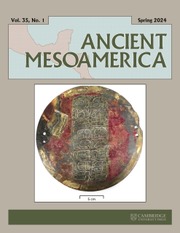Article contents
EFFIGY CENSER AND FIGURINE PRODUCTION AT THE POSTCLASSIC MAYA CITY OF MAYAPAN, MEXICO
Published online by Cambridge University Press: 10 August 2022
Abstract
The spatial contexts of effigy censer and figurine molds at Mayapan, Yucatan, Mexico suggest a tightly controlled industry in which elite representatives of state government and religious orders exerted oversight over production and distribution. Attached artisans at Mayapan made these and other restricted goods for residents of palaces and patrons of the city's public buildings. The study of effigy ceramic production reveals that, like earlier, Classic period Maya kingdoms, Postclassic elites also sponsored the crafting of symbolically charged goods. This finding expands understanding of Postclassic period economic organization, which is best-known for its expansive regional market exchange. The limited distribution of effigy censers and figurines further attests their primary use in the context of state-sponsored ceremonies and, to a lesser extent, high-status mortuary settings. Unlike other places and times in Mesoamerica, neither figurines nor effigy censers are representative of household-scale religious practice for the majority of urban residents at Mayapan.
- Type
- Research Article
- Information
- Copyright
- Copyright © The Author(s), 2022. Published by Cambridge University Press
References
REFERENCES
- 4
- Cited by



